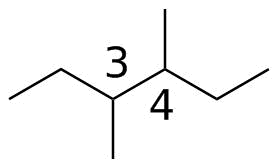Determine the reaction outcome
Show whether the product from monobromination of R, R-3,4-dimethylhexane will be optically active.
This question integrates many if not all of the concepts introduced in this chapter.
Analysis
First we need to identify the three-dimensional structure of the reactant and determine whether it is optically active. If we draw the core structure, we see that both carbons 3 and 4 are stereocenters in that each has as substituents an H, a methyl, an ethyl, and a 2-butyl group. You probably knew this already, since the name contains the Cahn-Prelog-Ingold designations for configuration of those atoms.

The simplest way to figure out R and S and draw this is probably trial and error: place a hydrogen down, and then assign priorities. 2-butyl > ethyl > methyl > H. In this depiction, we'd have both the C-3 hydrogen and the C-4 hydrogen up to get the R, R configuration (build the model):
Now we must ask: is the reactant chiral? If it is a meso compound, it will be impossible to get optically active products unless we engineer a chiral environment in which to perform the reaction. Make a model of the mirror image and see if it's different:
The mirror image is not superimposable, so each is chiral. Thus, the reactant would rotate plane polarized light and it would be optically active. It is possible that the reaction MIGHT result in an optically active product. We have to look at the outcome of all possible reactions.
We know that the mechanism (Chapter 3) involves selective substitution of bromine for hydrogen via a free radical mechanism:
- Br atoms are generated in an initiation step or steps;
- Br• abstracts a hydrogen atom from the weakest C-H bond, leaving a carbon radical;
- This radical reacts with Br2 to form the new C-Br bond and another Br• atom, which recycles to continue the chain.
(Termination from radical recombination ends things but is of little consequence for the vast majority of the molecules.)
So identify the weakest C-H bond: both C-3 and C-4 have 3° C-H bonds. These are symmetry-equivalent, so reaction of either forms the same radical. This radical is planar, and can attack Br-Br using either face. We would generate two different stereochemical outcomes, based on which face the bromine formed a bond from:

Were the reaction site the only stereocenter, the outcome would be a racemic mixture of two enantiomers. However, the presence of the second stereocenter that does NOT undergo reaction means that the two structures produced are diastereomers--they each have unique and different optical rotations, so the product mixture will be optically active.
(There is very unlikely possibility that the two diastereomers have opposite signs and that the mixture is such that the rotations exactly cancel. This would be a surprising coincidence of outcomes, but theoretically possible.)



